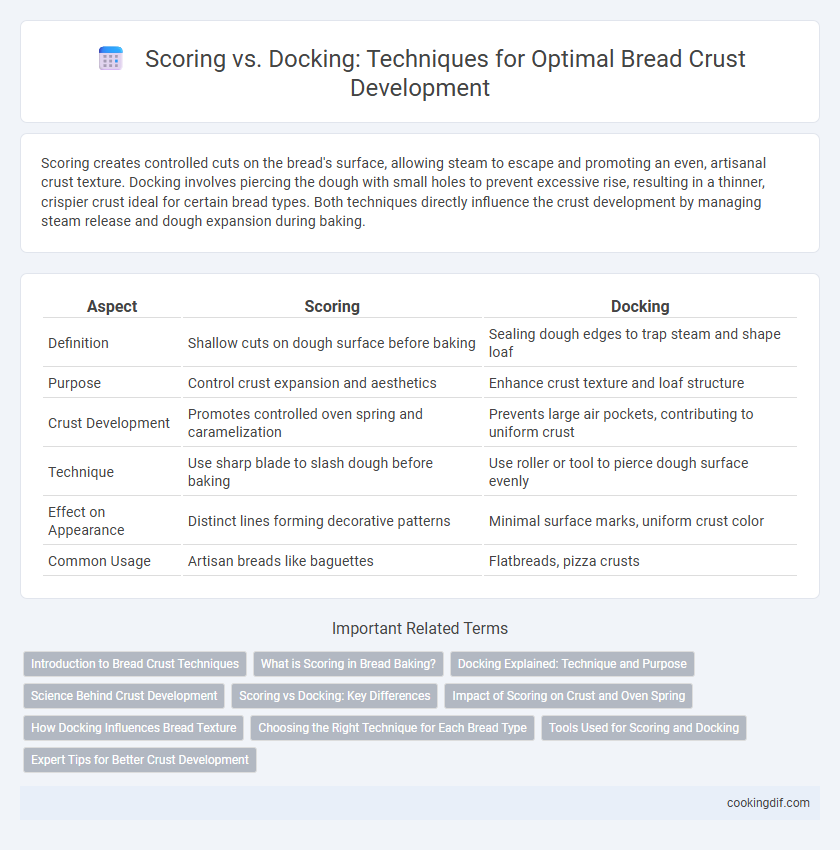Scoring creates controlled cuts on the bread's surface, allowing steam to escape and promoting an even, artisanal crust texture. Docking involves piercing the dough with small holes to prevent excessive rise, resulting in a thinner, crispier crust ideal for certain bread types. Both techniques directly influence the crust development by managing steam release and dough expansion during baking.
Table of Comparison
| Aspect | Scoring | Docking |
|---|---|---|
| Definition | Shallow cuts on dough surface before baking | Sealing dough edges to trap steam and shape loaf |
| Purpose | Control crust expansion and aesthetics | Enhance crust texture and loaf structure |
| Crust Development | Promotes controlled oven spring and caramelization | Prevents large air pockets, contributing to uniform crust |
| Technique | Use sharp blade to slash dough before baking | Use roller or tool to pierce dough surface evenly |
| Effect on Appearance | Distinct lines forming decorative patterns | Minimal surface marks, uniform crust color |
| Common Usage | Artisan breads like baguettes | Flatbreads, pizza crusts |
Introduction to Bread Crust Techniques
Scoring and docking are essential techniques for controlling steam release and crust development in bread baking. Scoring involves making deliberate slashes on the dough surface to guide expansion and create decorative patterns, enhancing both texture and appearance. Docking consists of puncturing the dough to prevent excessive rising and promote even crust formation by allowing steam to escape uniformly.
What is Scoring in Bread Baking?
Scoring in bread baking involves making deliberate slashes on the dough surface before baking to control expansion and create an attractive crust. These cuts allow gases to escape, preventing uncontrolled bursting, and contribute to a desirable crust texture and pattern. Proper scoring enhances oven spring and promotes even crust development, distinguishing it from docking, which involves poking holes to prevent excessive rising.
Docking Explained: Technique and Purpose
Docking in bread baking involves making small cuts or holes in the dough surface to control steam release during baking, preventing excessive puffing and ensuring an even crust. This technique promotes uniform heat penetration and consistent browning, enhancing the crust's texture and appearance. Docking is essential for flatbreads and thin crusts, maintaining shape without compromising the bread's structural integrity.
Science Behind Crust Development
Scoring the dough before baking directs steam release and controls expansion, promoting an even crust texture and preventing unwanted cracking. Docking creates small perforations that inhibit large air bubbles, resulting in a thinner, more uniform crust. Both techniques influence heat and moisture distribution, key factors in the Maillard reaction and caramelization processes responsible for crust color and flavor development.
Scoring vs Docking: Key Differences
Scoring involves making shallow cuts on the dough surface before baking, creating controlled expansion and decorative patterns, which enhances crust texture and appearance. Docking perforates the dough deeply to prevent excessive rising, resulting in a thinner, crisper crust by allowing steam to escape during baking. The key difference lies in scoring promoting oven spring and artisanal crust features, while docking inhibits puffing for uniform flatness and crunchiness.
Impact of Scoring on Crust and Oven Spring
Scoring bread dough creates controlled expansion points that significantly enhance oven spring by allowing trapped gases to escape during baking, resulting in a more voluminous and uniform loaf. The cuts promote a thinner, crispier crust formation along the score lines, contrasting with the thicker, tougher crust regions formed when dough is docked instead. Proper scoring depth and pattern directly influence crust texture and appearance, contributing to the artisan quality and visual appeal of the baked bread.
How Docking Influences Bread Texture
Docking bread dough creates small perforations that control gas expansion during baking, resulting in a more even crumb structure and preventing excessive bubbling on the crust. This technique influences bread texture by promoting a tender crust with uniform thickness, enhancing chewiness and overall mouthfeel. Compared to scoring, docking produces a subtle crust appearance while maintaining consistent internal moisture and softness.
Choosing the Right Technique for Each Bread Type
Scoring involves making precise cuts on dough surfaces to control expansion and create decorative patterns, ideal for artisan breads like sourdough and baguettes that benefit from controlled oven spring. Docking uses small perforations to release steam, preventing large air pockets and ensuring even baking, which suits softer breads such as sandwich loaves and pizza crusts. Selecting scoring or docking depends on desired crust texture, bread shape, and fermentation characteristics to optimize crust development and final bread quality.
Tools Used for Scoring and Docking
Scoring for crust development typically involves using sharp blades or lame tools to create precise cuts on the dough surface, allowing controlled expansion and enhancing the bread's texture and appearance. Docking employs specialized rollers or pins designed to perforate the dough evenly, preventing excessive air pockets and ensuring uniform baking. Both techniques rely on specific tools that influence the crust's final quality by managing gas release and oven spring during baking.
Expert Tips for Better Crust Development
Scoring bread dough before baking controls expansion, creating decorative patterns and preventing random cracking, which enhances crust texture and appearance. Docking, involving small perforations across the dough, allows steam to escape evenly, reducing large air pockets and promoting an even, crisp crust. Expert bakers recommend combining precise scoring with strategic docking to achieve consistent crust development, maximizing both aesthetic appeal and crunch.
Scoring vs Docking for crust development Infographic

 cookingdif.com
cookingdif.com